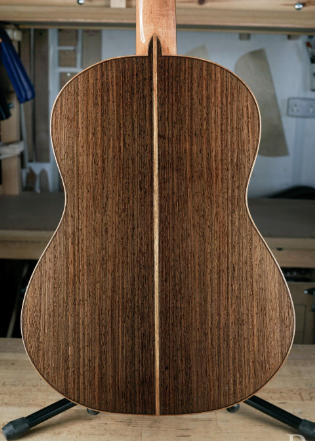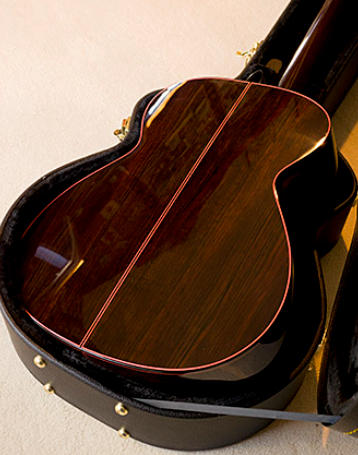Views: 222 Author: Rebecca Publish Time: 2025-10-28 Origin: Site











Content Menu
● Wenge Wood: Characteristics and Origins
>> Sonic Impact
● Technical Comparison: Wenge Versus Traditional Tonewoods
● Advantages of Wenge Guitar Necks
● Wenge in Modern Guitar Manufacturing
>> Boutique Luthiers and High-End Brands
>> Usage in Laminated “Super-Necks”
● Environmental and Ethical Considerations
● Market Trends: Wenge's Rising Popularity
● Choosing Wenge: Is It Right for You?
● FAQ
>> 1. Is wenge heavier than other neck woods?
>> 2. Does wenge need a finish?
>> 3. Is wenge suitable for acoustic and electric guitars?
>> 4. What does a wenge neck cost compared to alternatives?
>> 5. Are there environmental issues with wenge?
Wenge wood, scientifically known as Millettia laurentii, has attracted significant attention in the world of luthiery and guitar manufacturing. Popular for its striking dark color, bold grain, and superior stability, it's increasingly featured not just for fingerboards, but for entire guitar necks. But what exactly makes wenge special, and is it worth considering for your next instrument?

Wenge is a tropical hardwood native to Central Africa, predominantly found in Congo, Gabon, and Cameroon. The wood displays a rich, nearly black hue with subtle chocolate brown undertones and parallel streaks, providing a visually arresting appearance in any guitar build.
- Density: Wenge is notably dense (Janka hardness ≈ 1630 lbf), surpassing common neck woods like mahogany and even rivaling maple for toughness.
- Stability: Its tight grain pattern reduces the risk of warping, twisting, or dead spots in the neck over decades.
- Texture: The coarse, open-pored texture not only adds a unique tactile feel but also makes each neck visually distinctive.
These features deliver not only a signature look but structural dependability ideally suited for guitar necks, which experience constant pressure from string tension and humidity shifts.
One of the leading benefits of wenge is its exceptional dimensional integrity over time, provided the wood is properly seasoned before use. This stability is a crucial attribute, as guitar necks inevitably endure fluctuating temperatures and humidity. Wenge's low movement minimizes truss rod adjustments and helps instruments stay in top playing condition, even during long tours or in challenging climates.
Wenge's effect on tone is distinctive:
- Articulation and Resonance: Wenge is recognized for fast attack, clarity, and enhanced upper-mids, giving notes a certain brightness and “bite” that cuts through dense mixes.
- Sustain and Note Separation: Its hardness results in clear note separation and excellent sustain, especially in complex chord voicings or single-note runs.
- Balanced Low End: While not quite as deep as mahogany, wenge delivers a tight, focused low end that suits technical genres and studio work.
With its rough, open-grain surface, wenge offers natural grip, making it less likely for hands to feel sticky during extended performances—a key benefit for players who dislike the slick feel of finished maple necks. Most manufacturers keep wenge oiled or unfinished, preserving direct player-to-wood connection and enhancing control.
Few woods are as visually dramatic as wenge. Its deep color and dark striping offer a sense of luxury and uniqueness, directly appealing to players seeking to stand out. The grain can sometimes feel almost three-dimensional under the light, making every neck unique.
| Feature | Wenge | Maple | Mahogany | Rosewood |
|---|---|---|---|---|
| Density | High | High | Medium | High |
| Tone | Bright, snappy | Bright, articulate | Warm, resonant | Smooth, dark |
| Dimensional Stability | Excellent | Excellent | Good | Good |
| Grain/Texture | Coarse, open | Tight, closed | Moderately fine | Oily, fine |
| Finish Needed | Often unfinished | Usually finished | Usually finished | Usually finished |
| Aesthetic | Striking dark streaks | Blonde & uniform | Subtle, reddish-brown | Chocolate/brown |
| Availability | Scarcer, premium | Common | Common | Less common, premium |
Wenge and maple are both highly stable, but wenge offers a more tactile feel. It provides a brightness different from rosewood or mahogany, making it desirable for genres needing articulation and tight response.
- Structural Integrity: Less susceptible to bowing, twisting, or structural defects over time.
- Tonal Sharpness: Emphasizes clarity and mids, helping intricate playing stand out in recordings and ensemble settings.
- Comfort and Grip: Organic, coarse texture keeps hands comfortable and in control—even with sweat and stage lights.
- Unique Appearance: No two pieces of wenge are identical, adding exclusivity to every custom instrument.
- Low Upkeep: Typically requires only sporadic oiling and little beyond routine cleaning.

- Cost: Wenge is pricier than mainstream options like maple or mahogany, partly due to limited availability and sustainability pressures.
- Workability: Its hardness and open-grain structure may pose challenges for luthiers, increasing the risk of splinters or rough edges if not handled with care.
- Weight: Wenge necks are generally heavier, which can make some guitars noticeably weightier and may result in “neck dive” depending on body shape and hardware.
- Potential Allergens: Some individuals may experience irritation from wenge dust—precautions like respirators and gloves are advised in the workshop.
- Sustainability Concerns: As a vulnerable species, responsible sourcing is critical; buyers and builders should favor FSC-certified suppliers.
Notable manufacturers and custom builders are increasingly integrating wenge in contemporary guitar lines:
- Ibanez: Several models feature wenge necks or multi-laminate necks (wenge/bubinga), highlighting durability and tight sonic character.
- Mayones: This Polish company is renowned for wenge-based or multi-lam necks—cited for their performance and resistance to warping.
- Custom Builders: Small workshops use wenge for exclusive builds, ranging from precision basses to avant-garde electric guitars.
Artists praise wenge for facilitating fast, technical play, as well as the extra “snap” in picking articulation. Those prone to sweaty hands also appreciate its unfinished, non-sticky feel.
Wenge often appears in laminated neck constructions, where its stiffness complements other woods (such as maple or purpleheart) to create necks with superior strength and intricate aesthetics.
Wenge's tough nature makes routine care straightforward:
- Oiling: Occasional application of lemon or tung oil keeps the wood hydrated and enhances its grain.
- Humidity Control: While dimensionally stable, it's best to store instruments in environments with moderate, consistent humidity—avoiding extremes.
- Cleaning: Dust with a soft cloth as needed. Deep cleaning is rarely required if oiling is maintained.
Light scratches or bumps can be addressed by gently sanding and reapplying oil—its coarse grain makes minor blemishes less visible compared to smoother woods.
Wenge is listed as “Vulnerable” due to illegal logging and unsustainable harvesting practices, making responsible purchasing essential. Prominent luthiers advocate for selective, certified-use only.
- FSC Certification: Always ask suppliers for FSC-certified stock, ensuring traceability and legal harvesting.
- Supporting Reforestation: Some custom builders participate in tree-planting initiatives to offset raw material impact.
- Alternatives and Hybrids: Where sourcing is questionable, hybrid or laminate necks can reduce total wenge consumption without compromising performance.
Emerging regulations may restrict wenge export/import, increasing its price and desirability in boutique markets. Buyers should anticipate possible waiting times and rising costs.
Wenge's high demand among pro musicians and collectors has made it a fixture in premium guitars. Consumers increasingly associate wenge necks with quality, exclusivity, and modern design sensibilities. This desirability is driven by:
- Technical players seeking clarity and fast attack.
- Visual aesthetics favoring dark, dramatic woods.
- Boutique builders marketing “alternative tonewoods” for eco-conscious or limited-edition models.
Opting for a wenge neck is about priorities. If you value a unique tactile experience, punchy tone, and striking looks over minimum cost, wenge is hard to surpass for custom and high-end instruments. For the casual player or budget-focused buyer, mainstream alternatives might be more practical.
Wenge wood provides a compelling mix of structural excellence, unique tactile appeal, and distinctive sound, making it a persuasive choice for guitar necks in the boutique and professional market. Its density, stability, and bright, clear tonal signature have made it popular among discerning musicians and luthiers. However, buyers must weigh the challenge of cost, workability, and, most importantly, the environmental impact. Always ensure your wood is ethically sourced—favoring FSC-certified materials helps sustain global wenge resources for generations of musicians and builders to come. Serious players or brands seeking true distinction in tone and appearance will find wenge an investment worth making.

Yes. Wenge's density makes it heavier than maple or mahogany, thereby increasing guitar weight but contributing to stability and durability.
Usually, wenge necks are left unfinished or lightly oiled to enhance natural grip and player comfort.
Yes. Its tonal qualities work well for both types, though it is especially favored in electrics for clarity and immediate response.
Wenge is more costly due to scarcity and processing complexity. Boutique or custom models with wenge necks are often priced as premium products.
Yes. Wenge is “Vulnerable” due to overharvesting. Prioritize FSC-certified sources and confirm your supplier's commitment to ethical forestry.